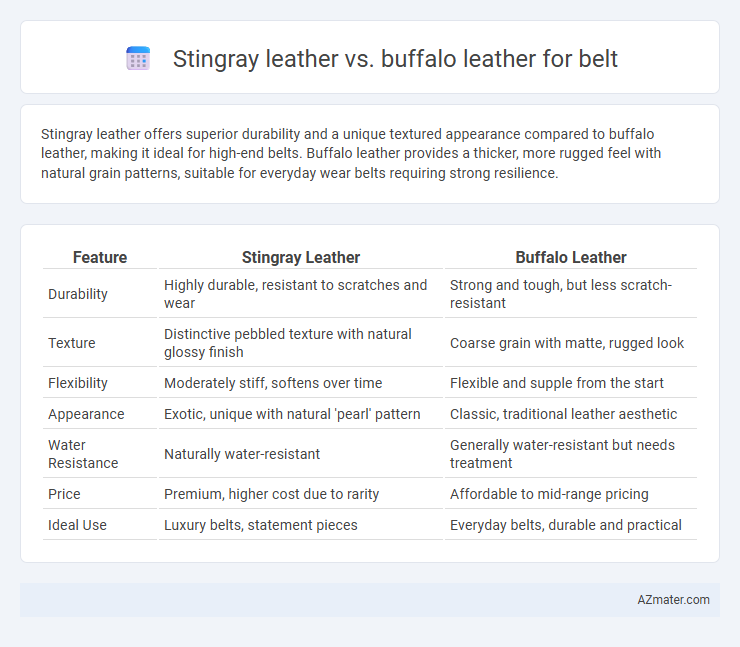Stingray leather offers superior durability and a unique textured appearance compared to buffalo leather, making it ideal for high-end belts. Buffalo leather provides a thicker, more rugged feel with natural grain patterns, suitable for everyday wear belts requiring strong resilience.
Table of Comparison
| Feature | Stingray Leather | Buffalo Leather |
|---|---|---|
| Durability | Highly durable, resistant to scratches and wear | Strong and tough, but less scratch-resistant |
| Texture | Distinctive pebbled texture with natural glossy finish | Coarse grain with matte, rugged look |
| Flexibility | Moderately stiff, softens over time | Flexible and supple from the start |
| Appearance | Exotic, unique with natural 'pearl' pattern | Classic, traditional leather aesthetic |
| Water Resistance | Naturally water-resistant | Generally water-resistant but needs treatment |
| Price | Premium, higher cost due to rarity | Affordable to mid-range pricing |
| Ideal Use | Luxury belts, statement pieces | Everyday belts, durable and practical |
Introduction to Stingray and Buffalo Leather
Stingray leather, known for its unique, pebble-like texture and exceptional durability, originates from the tough outer skin of stingrays, offering a high resistance to scratches and water. Buffalo leather, derived from the hide of water buffaloes, features a coarse, rugged grain that provides a sturdy yet flexible material ideal for daily use belts. Both leathers are prized for their strength and aesthetic appeal, but stingray leather stands out for its distinctive pattern and superior hardness compared to the more traditional, softer buffalo leather.
Origin and Sourcing of Each Leather
Stingray leather is predominantly sourced from Southeast Asia, particularly Thailand, where stingrays are abundant in coastal waters and harvested sustainably to support local fisheries. Buffalo leather mainly originates from India, China, and Southern Europe, obtained from domesticated water buffaloes raised on farms, ensuring consistent quality and availability. The distinct ecosystems and animal husbandry practices influence the texture and durability characteristics unique to each leather type used in belt production.
Unique Appearance and Texture Comparison
Stingray leather features a distinctive pebbled texture with a natural, glossy finish that creates a shimmering effect, making each belt uniquely eye-catching. Buffalo leather offers a coarse, grainy texture that is more rugged and matte, providing a sturdy and durable option with a natural, earthy look. The choice between stingray and buffalo leather belts ultimately highlights a preference for striking elegance versus robust simplicity in appearance and texture.
Durability and Longevity
Stingray leather offers exceptional durability due to its dense, pebble-like texture and natural calcium deposits, making it highly resistant to scratches and wear. Buffalo leather is known for its toughness and flexibility, with a thicker grain that withstands heavy use but may develop a patina over time. For belts, stingray leather typically provides longer-lasting resilience and maintains its appearance better than buffalo leather, which can soften and show signs of aging more prominently.
Flexibility and Comfort in Belts
Stingray leather offers exceptional flexibility due to its dense, pebbled texture that molds comfortably to the wrist or waist over time, making it ideal for belts that require both durability and adaptability. Buffalo leather, while thicker and more robust, provides a sturdier feel with moderate flexibility, offering long-lasting comfort but less immediate softness compared to stingray leather. For belts prioritizing a balance of comfort and flexibility, stingray leather excels in conforming to body movements, whereas buffalo leather suits users seeking a firm, resilient belt.
Maintenance and Care Requirements
Stingray leather requires minimal maintenance due to its natural water resistance and durable, abrasion-resistant surface, making it ideal for belts exposed to moisture and frequent wear. Buffalo leather demands regular conditioning and protection from excessive moisture to prevent drying and cracking, ensuring longevity and softness. Both materials benefit from gentle cleaning with a damp cloth, but stingray leather's unique texture offers superior durability with less intensive care.
Price and Value for Money
Stingray leather belts typically carry a higher price due to their unique texture, durability, and exotic appeal, making them a premium choice for fashion enthusiasts. Buffalo leather belts offer strong value for money with their robust quality and affordability, providing long-lasting use at a lower cost. When considering price and value, stingray leather emphasizes exclusivity and luxury, while buffalo leather prioritizes practicality and cost-efficiency.
Environmental and Ethical Considerations
Stingray leather is often considered more sustainable than buffalo leather due to its rapid growth rate and minimal environmental impact in mariculture farms. Buffalo leather production involves land use, higher water consumption, and methane emissions linked to cattle farming, raising more significant ecological concerns. Ethically, stingray harvesting practices are scrutinized for wild population impacts, while buffalo leather sources vary widely depending on livestock welfare standards and regulatory enforcement.
Style and Fashion Versatility
Stingray leather offers a unique, glossy texture with a natural pebble pattern, making it a bold fashion statement ideal for high-end, luxury belts that stand out. Buffalo leather provides a matte, rugged finish that complements both casual and formal styles, offering versatile durability and a classic aesthetic. Choosing between stingray and buffalo leather depends on whether you prefer an eye-catching, exotic look or a timeless, adaptable accessory for versatile styling.
Final Verdict: Which Leather is Best for Belts?
Stingray leather offers unparalleled durability, unique texture, and natural water resistance, making it a premium choice for high-end belts that demand longevity and distinct style. Buffalo leather provides a robust, rugged appeal with a thicker grain, ideal for belts requiring flexibility and classic aesthetics at a more affordable price. The best leather for belts ultimately depends on the desired balance between luxury, durability, and budget, with stingray leather excelling in exotic appeal and buffalo leather excelling in practicality.

Infographic: Stingray leather vs Buffalo leather for Belt
 azmater.com
azmater.com